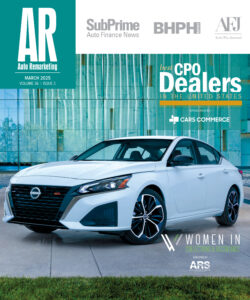CarMax Opens Fiscal Year with Strong Sales, Revenue Performances
RICHMOND, Va. — CarMax posted significant gains in just about every financial category during the first quarter of its fiscal year that concluded May 31. From net sales and operating revenues to net earnings as well as total used unit sales, company executives detailed positive advancements of 9 percent and more for each.
Among the broad highlights of CarMax's latest financial report were a 23-percent net sales and operating revenues increase as compared to the year-ago quarter. The total climbed to $2.26 billion from $1.83 billion.
Executives also noted comparable-store used unit sales increased 9 percent during the quarter while total used-unit sales rose by the identical rate, 9 percent
CarMax also determined its net earnings spiked an astounding 252 percent to $101.1 million, or 44 cents per diluted share. The company compared those figures with the ones from the first quarter of fiscal 2010, which were $28.7 million, or 13 cents per diluted share.
Deeper Analysis of Sale Performance
CarMax revealed its wholesale unit sales increased 52 percent during the most recent quarter as compared with the year-ago time frame. The company attributed the improvement to significant increases in both appraisal traffic and appraisal buy rate, as well as the easy comparison with the prior-year period.
Executives noted their buy rate has steadily strengthened during the last several quarters to slightly above 30 percent.
"We believe this reflected favorable consumer response to our higher appraisal offers, which largely resulted from the strength of wholesale industry used-vehicle pricing," CarMax officials contended.
Elsewhere, the company pointed out extended service plan revenues jumped 20 percent. CarMax indicated the increase reflected both growth in its retail-vehicle sales and the fiscal 2010 rollout of a guaranteed asset protection product.
Executives emphasized this increase was more than offset by the decline in net third-party finance fees. They explained the change in third-party finance fees primarily constituted a mix shift among providers, including a significant increase in the percentage of vehicle sales financed by their subprime finance provider.
CarMax stressed that its previously announced arrangement with Santander Consumer USA was renewed on favorable terms. The company stated that under the agreement, Santander is purchasing a large portion of the loans that CarMax Auto Finance would have originated prior to CAF's tightening of lending standards in 2009.
Tom Folliard, president and chief executive officer of CarMax, shared some commentary about this segment of the company's financial performance.
"We are pleased to report another quarter of healthy increases in both used and wholesale vehicle unit sales," Folliard said.
"Our 9-percent increase in comparable-store used unit sales reflected the benefit of a continuing gradual rebound in customer traffic, as well as the easy year-over-year comparison," he continued. "Sales execution remained strong, as our stores were able to maintain the recent gains in the sales conversion rate."
More Profit Discussion
Continuing the parade of positive news, CarMax revealed its total gross profit moved up by 21 percent in the first quarter. The figure came in at $333.5 million as compared to $276.2 million in the first quarter of its 2010 fiscal year.
Executives believed the combination of the increase in unit sales and an improvement in total gross profit dollars per retail unit sparked to the gross profit performance. They mentioned the per unit figure climbed by $325 to $3,236 per vehicle. In the prior year, CarMax posted $2,911 per unit.
Specifically in reference to used-vehicle gross profit per unit, CarMax noted an increase here as well. The amount edged higher to $2,212 per unit from $2,001 per unit in the prior-year quarter.
"The continued strength of our used-vehicle gross profit reflected the combination of several factors, including a year-over-year increase in the percentage of retail vehicles sourced directly from consumers through our appraisal process, the support provided by the continued strength in wholesale industry valuations, benefits realized from our initiatives to reduce vehicle reconditioning costs and our strong inventory turns," CarMax executives explained.
Turning to figures about wholesale vehicle gross profit per unit, the company spotted an increase here, too. The per-unit amount moved up from $904 a year ago to $942 in the most recent quarter.
"The strong industry wholesale price appreciation continuing from last year contributed to the increase in gross profit per unit, and we continued to achieve strong dealer attendance and dealer-to-car ratios at our auctions," company executives highlighted.
Highlights of CarMax Auto Finance
One of the company's greatest year-over-year turnarounds came in regards to CAF. The company enjoyed an income amount totaling $57.5 million in the most recent quarter. During the first quarter of the 2010, CAF sustained a loss of $21.6 million.
In the prior year period, executives reiterated that CAF results were reduced by adjustments totaling $40.4 million related to loans originated in previous fiscal years. They went on to note these adjustments included $57.6 million of increased funding costs related to the $1.22 billion of auto loan receivables that were funded in the warehouse facility at the end of the previous fiscal year, partially offset by $17.2 million of favorable valuation adjustments.
Returning to the most recent quarter, the company determined CAF income was 5.5 percent of average managed receivables on an annualized basis. Executives pointed out CAF's current profits reflected both the low benchmark interest rates and the dramatic improvement in credit spreads in the term securitization market.
CarMax added the provision for loan losses in the first quarter reflected favorable trends in net charge-offs and a very high recovery rate relative to historical norms. The company said net charge-offs also were significantly below both its forecast and prior-year trends.
"The lower-than-expected losses and the resulting adjustment to the allowance for loan losses related to future periods favorably affected net income by approximately 3 cents per share," CarMax executives shared.
Update on SG&A
CarMax also mentioned its selling, general and administrative expenses increased 10 percent to $226.7 million from $206.2 million in the prior year's first quarter. The company contends the rise in SG&A primarily stemmed from boosts in sales commissions and other variable costs associated with the 9-percent increase in used-unit sales, as well as the absence of the 2 cents per share litigation benefit reflected in the prior year quarter.
"In addition, we modestly increased our advertising spending per unit sold, and we incurred preopening costs in connection with the resumption of store growth this year," stated company executives, who rolled out a new dealership in Augusta, Ga., during the first quarter.
The company added its SG&A ratio improved to 10 percent during the most recent quarter, compared with 11.2 percent in the year-ago span. It mentioned how this change was connected with the leverage associated with the increases in both average selling prices and unit sales.
Quarterly Summation
CarMax highlighted that its next quarterly financial performance should be impacted with two more store openings. Earlier this month, the company unveiled rooftops in the Cincinnati and Dayton markets, doubling its presence in Ohio. More details about those facilities are available through this story from SubPrime Auto Finance News.
Folliard wrapped up the CarMax quarterly financial discussion by remaining cautious. He took that stance since he believes customer traffic appears to be gradually improving, but the sales environment remains well below pre-recession levels
"We are once again extremely pleased with our ability to generate strong earnings growth, through a combination of comparable store sales increases, enhanced gross profits, a strong CAF contribution and continuing efforts to control costs and reduce waste throughout the organization," Folliard concluded.

 View The Latest Edition
View The Latest Edition

